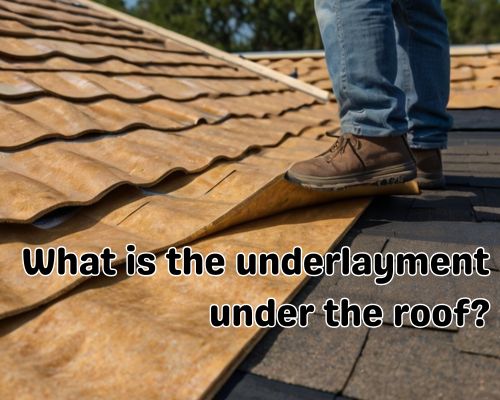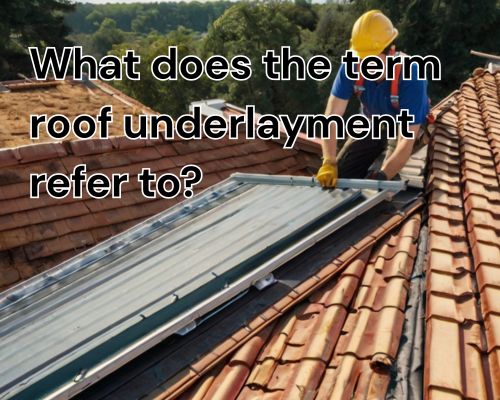If you’ve ever asked, “What is the underlayment under the roof?”—you’re not alone. While most homeowners in West Palm Beach, Florida focus on roofing materials like shingles or tiles, there’s a critical component just beneath that often goes unnoticed: the roofing underlayment. This hidden layer plays a starring role in protecting your home from moisture, wind, and the harsh coastal climate typical of South Florida.

With Star Roofing, let’s dive into what roofing underlayment is, the types available, how it works, and why it matters specifically for homes in West Palm Beach.
What Is the Roofing Underlayment?
The underlayment under the roof is a water-resistant or waterproof barrier that sits directly on the roof deck, underneath the outer roofing material (such as asphalt shingles, metal panels, or clay tiles). Its purpose is to serve as a secondary line of defense against elements like wind-driven rain, extreme humidity, and, in the case of West Palm Beach, potential hurricane conditions.
Salient Entities:
- Roof deck
- Asphalt shingles
- Synthetic underlayment
- Roofing felt
- Ice and water shield
- Moisture barrier
- Wind uplift resistance
Why Roofing Underlayment Matters in West Palm Beach, Florida
West Palm Beach homeowners are no strangers to extreme weather. With hot, humid summers and a hurricane season that stretches from June to November, the underlayment becomes crucial. Here’s why:
1. Hurricane Protection
Florida building codes require roofing systems to withstand high winds. The roof underlayment helps maintain a waterproof seal even if the outer roofing material is damaged during a storm. It acts as a critical barrier against water intrusion, a leading cause of structural damage.
2. Humidity and Mold Resistance
High humidity can lead to condensation beneath the roof deck. Quality underlayment prevents this moisture from seeping into your home, reducing the risk of mold and rot—common concerns in coastal climates.
3. Compliance With Florida Building Code
Underlayment requirements in Florida have evolved significantly post-Hurricane Andrew. Today, compliance includes specific installation techniques and materials, such as peel-and-stick waterproof membranes and synthetic underlayment, especially in areas like Palm Beach County.
Types of Roof Underlayment (With Pros and Cons)
Let’s look at the most common types of underlayment used in residential roofing projects across West Palm Beach.
1. Asphalt-Saturated Felt (Roofing Felt)
- Pros: Affordable, time-tested, and easy to install.
- Cons: Less durable, tears easily in high winds, absorbs moisture over time.
- Best for: Budget-conscious homeowners or homes not exposed to frequent storm events.
2. Synthetic Underlayment
- Pros: Lightweight, tear-resistant, water-repellent, and UV-resistant.
- Cons: Slightly more expensive than felt but far more durable.
- Best for: Homes in coastal or high-wind zones like West Palm Beach or Boynton Beach.
3. Rubberized Asphalt (Self-Adhering Membranes)
- Pros: Superior waterproofing, excellent adhesion, self-sealing around nails.
- Cons: Costlier and heavier to install.
- Best for: High-risk areas, especially hurricane-prone neighborhoods in Palm Beach County.
How the Underlayment Works with the Entire Roofing System
Think of the roofing underlayment as your roof’s internal armor. It supports the overall system that includes:
- Rafters and decking
- Drip edge flashing
- Ice and water shield
- Shingles or tiles
- Ventilation systems
When installed correctly, these components work synergistically to manage water runoff, improve thermal efficiency, and extend the lifespan of your roof—an especially smart investment in a location like West Palm Beach, where real estate values are rising and curb appeal is everything.
Local Considerations: Choosing the Right Underlayment in West Palm Beach
Here’s where local knowledge counts. Not all roofing underlayment is created equal, and what works in dry, inland areas may not cut it in a subtropical environment.
Factors to Consider:
- Proximity to the ocean: Salt spray can corrode certain roofing materials; synthetic underlayment often offers better resistance.
- Building code updates: Palm Beach County mandates stricter requirements for homes near the coastline.
- Insurance incentives: Some insurers offer discounts for homes using approved water-resistant underlayment.
Local LSI Keywords:
- South Florida roofing
- Palm Beach County building code
- Roof replacement West Palm Beach
- Hurricane roof prep Florida
- Florida wind mitigation
- Moisture barrier installation
FAQs About Roofing Underlayment
Q: Do I really need underlayment if I have shingles?
A: Yes. Shingles alone can’t seal out water—especially during West Palm Beach’s tropical downpours. Underlayment is essential for waterproofing.
Q: How long does roof underlayment last?
A: Depending on the type, underlayment can last between 20 to 50 years. Synthetic versions offer the longest lifespan, making them ideal for Florida homes.
Q: Is it worth upgrading to peel-and-stick?
A: In high-risk areas like West Palm Beach, absolutely. The cost upfront pays off by preventing costly water damage and may qualify you for wind mitigation credits.
Final Thoughts: Don’t Skip the Layer That Saves Your Roof
So, what is the underlayment under the roof? It’s not just a technicality—it’s your home’s frontline defense against Florida’s fiercest elements. If you’re planning a roof replacement or repair in West Palm Beach, make underlayment a top priority.
Talk to licensed roofing contractors familiar with Florida building codes and Palm Beach County permits. A quality underlayment not only protects your investment but also boosts energy efficiency, resale value, and peace of mind.
Call to Action
Looking to upgrade or inspect your roof underlayment in West Palm Beach, FL? 🌴
Get a free consultation from certified local roofers who specialize in storm-ready roofing systems. Make sure your home is sealed, secure, and future-proof!

